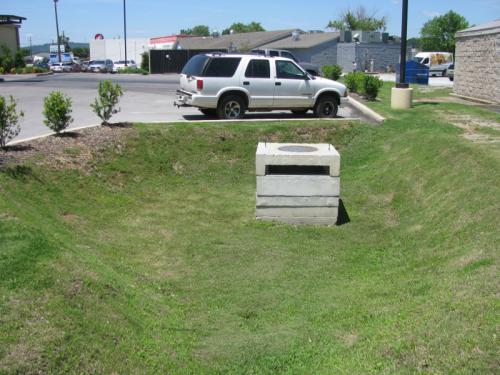Either detention or retention equals storm water runoff reductions
Storm water management continues to be an important aspect of new development. Efforts to decrease runoff from increased impervious surfaces through detention and/or retention ponds results in more water infiltration and less runoff.

New construction in business or residential areas causes a cascade effect on the health of the ecosystem. More economic activiy results in increased impervious surface and less vegetative cover causing more storm water runoff, with potential pollutants, running into the water resources (lakes, rivers or streams). In many of these developments, the use of storm water ponds is a positive way to control runoff.
Storm water ponds can be detention or retention ponds depending on their function. But what is the difference between the two? With either type the benefits are the same:
- To collect and hold storm water
- To filter pollutants out of storm water runoff
- Reduce erosion of land into local water courses
- Reduce flooding down stream
Both types of ponds are manmade depressions in the ground that collect and hold storm water, slowing the rate of surface runoff and improving water quality leaving the pond through infiltration into the ground.
Generally, detention ponds that only provide flood control measures are called dry ponds. The size or volume needed for the depression in the ground is determined by comparing pre-development and post-development runoff volumes. A control device is placed at the bottom of the depression so all the water collected during a storm is drained out during a specific time period to ensure volume availability for the next storm.

Detention pond in Gadsden, AL adjacent to a commercial parking lot. The curb cutoff for water drainage is visible near the car’s front tire.
In contrast to a detention pond, a retention pond is designed to hold a permanent fixed amount of water all the time and are often referred to as wet ponds. Retention ponds are typically found in areas with a high water table, such as in Southeast Michigan. The pond is dug out below the water table level to establish a permanent pool.
Think of when you dig a hole at the beach, once it’s deep enough, the water that collects in the hole stays there and forms a pond. The control device is set at the level of the water table (not at the bottom of the pond) as in a detention pond. This allows any water above the water table to drain off infiltrating the ground around the pond while leaving the desired water amount in the pond.
In most cases, retention ponds require more space than detention ponds due to making adjustments for pond vegetation. Retention ponds add more aesthetic and/or recreational amenities, habitat for wildlife and increased pollutant removal than detention ponds.
In more recent developments, elements of both detention and retention ponds are combined in storm water management ponds. Essentially the detention volume of water is stacked on top of the retention volume of water using the control device. The device is located at the desired level of the retention elevation. The detention water drains out leaving the retention water permanently in the pond.
For information on how to maintain your pond to insure its optimal storm water management, read Maintaining your storm water management pond.
“Maintaining Your Detention Pond” is a guidebook available from the Alliance of Rouge Communities that provides more detailed information. To learn more about this guidebook, read the Michigan State University Extension article here.



 Print
Print Email
Email


